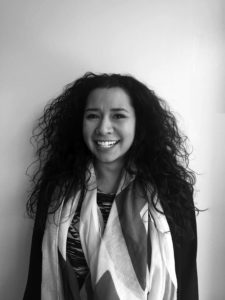NASCENT PRACTICE MODELS FOR SOCIAL IMPACT
Katherine Darnstadt, AIA, LEED AP BD + C, NCARB
Founder and Principal Architect, Latent Design
Chicago, Illinois

Why did you become an architect?
I think about this question a great deal and try to always find a better answer.
Sometimes I think it was the years hanging out in the shop and job sites of my father’s electrical contracting company on weekends while he worked in the office, or the sophisticated mechanical pencils he would bring home that blew away my yellow, wooden 2B. Other times I am sure my prior studies in philosophy had something level of influence on me. Maybe it was a naïve but bold desire for equity that needed a profession to be able to manifest itself.
I chose architecture to create a space for everyone.
I created Latent Design because I got laid off from architecture.
I had to decide, very quickly, if I wanted to be an architect or not. I chose the former and over time, have created a demand for the firm that allows it to practice the creation of space at all scales in ways that are sometimes not traditionally architecture.
"I chose architecture to create a space for everyone."
Why did you decide to choose the school, Illinois Institute of Technology? What degree(s) do you possess?
I graduated from IIT in 2005 with a professional bachelor degree in Architecture. I selected IIT because of the materials based program deeply entrenched in a modernist pedagogy that happened to be situated on a campus in a neighborhood undergoing dramatic transition. Studying architecture while witnessing the demolition and creation of architecture and subsequent social upheaval was an important factor in my decision.
LATENT DESIGN is a full-service architecture and design collaborative developing innovative solutions to social issues for underrepresented individuals and communities; Please outline why the passion for public interest design.
All design is within the public interest.
Whether pro bono, which means ‘for good’, without monetary compensation or $30M museum, the profession has always impacted the public, and architects uniquely think about the public, but it has not been framed that way. While Latent Design may seek to use design as a form of social justice localized within our Chicago communities, what we collectively call good design as architects’ impacts individuals through social, environmental, and economic impact. The design we create needs to be sustainable not only in the environmental sense, but viable as a long-term economic driver for a community.
What are your primary responsibilities and duties as founder and principal? Please describe a typical day.
The typical day for Latent Design as a start up architecture firm is about 10 hours long and involves work in every area of the business at all levels. The roles necessary myself as founder and for the first years the only architect included marketing, accounting, intern, project manager and principal. Meetings with clients take place, proposals are written, cad drawings are redlined and new concepts developed. As the firm is growing, time now includes collaborating with employees and researching storefront office spaces. Each day is rigorous, sometimes uneventful, but always enjoyable.
What has been your greatest challenge as an architect?
Empathetic design, understanding other professions that shape the built environment and their role/influence, examples of firms that utilized these methods currently as inspiration.
What is the most / least satisfying part of being an architect?
The most satisfying part of being an architect is being able to hear the stories behind the organization and people and then manifesting that into a space and place. The biggest challenge, and sometimes least satisfying part of being an architect is trying to incorporate design into advocacy and policy initiatives.
Who or what experience has been a major influence on your career?
Recently, during a community design workshop for a project which was full of the prescribed tools of design workshops of post it notes and sharpie markers, I had a participant come up to me at the end. She thanked me for the time and workshop, but informed me, quite succinctly, that a Post-It Note is not a job. This building I was creating and this process of design I was advocating for needed to create jobs, skills and economic opportunity. I thought about this for some time, and since that meeting, I have taken on the model of vertical integration, common in manufacturing, to hire local community members as consultants to our design team to help us define the context of a place more accurately so we can design the context more authentically.
